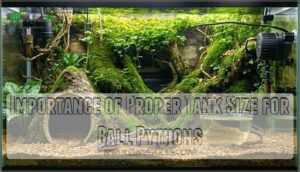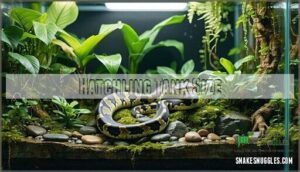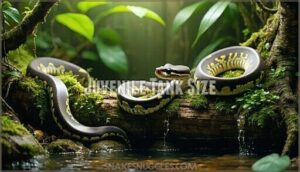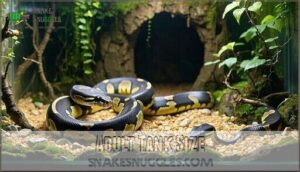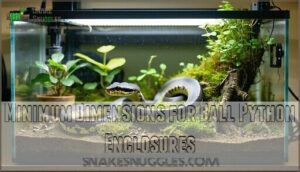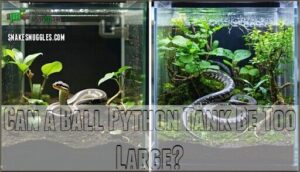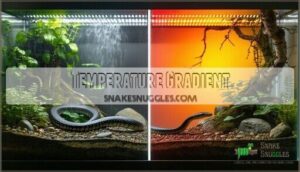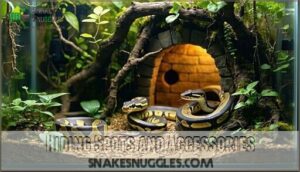This site is supported by our readers. We may earn a commission, at no cost to you, if you purchase through links.
 Your ball python tank size should be at least 40 gallons for adults, but bigger is better. A good rule of thumb: your enclosure’s length should equal one-third of your snake’s body length, so a 5-foot python needs roughly 20 inches minimum.
Your ball python tank size should be at least 40 gallons for adults, but bigger is better. A good rule of thumb: your enclosure’s length should equal one-third of your snake’s body length, so a 5-foot python needs roughly 20 inches minimum.
However, this barely meets basic needs. Most ball pythons thrive in 75-120 gallon setups that allow natural behaviors like exploring and climbing.
Cramped quarters stress your snake, leading to feeding refusal and health problems. Think of it like living in a closet versus a comfortable room.
The right tank size varies by age, with hatchlings starting smaller and gradually upgrading as they grow.
Table Of Contents
- Key Takeaways
- Importance of Proper Tank Size for Ball Pythons
- Recommended Tank Sizes for Different Life Stages
- Factors Affecting Tank Size Requirements
- Minimum Dimensions for Ball Python Enclosures
- Can a Ball Python Tank Be Too Large?
- Setting Up The Ideal Ball Python Habitat
- Frequently Asked Questions (FAQs)
- What is the perfect tank size for a ball python?
- Is a 60 gallon tank good for a ball python?
- Is a 20 gallon big enough for a ball python?
- Is a 40 gallon tank too big for a baby ball python?
- Is a 35 gallon tank big enough for a ball python?
- What size tank is best for a ball python?
- What is the average size of a ball python?
- What are the minimum dimensions for a ball python enclosure?
- How long do ball pythons grow?
- Is a 40 gallon tank good for a ball python?
- Conclusion
Key Takeaways
- Start with proper sizing for your snake’s age – You’ll need 10 gallons for hatchlings, 20-40 gallons for juveniles, and 40-75+ gallons for adults to prevent stress and health issues.
- Prioritize length over height in your enclosure – Your tank’s length should equal at least one-third of your python’s body length, with 24+ inches of width for adults to allow natural coiling and movement.
- Don’t worry about going too large if you set it up right – Oversized tanks only stress pythons when they’re bare, but proper enrichment with multiple hides, branches, and dense décor makes larger spaces comfortable.
- Cramped quarters cause serious problems – Too-small enclosures lead to feeding refusal, stress behaviors, and restrict your python’s ability to thermoregulate and express natural behaviors.
Importance of Proper Tank Size for Ball Pythons
When choosing your ball python tank size, you’re setting the stage for your snake’s entire quality of life.
Proper snake enclosure size directly impacts stress reduction and health impacts—too small restricts movement, while oversized tanks can overwhelm younger pythons.
The right ball python enclosure supports behavioral needs like exploring and hiding, maximizing space utilization for long-term wellbeing.
Your snake’s tank size becomes its complete world, affecting everything from feeding confidence to natural thermoregulation behaviors.
Ideal setups often include cypress mulch substrates for humidity control.
Recommended Tank Sizes for Different Life Stages
Your ball python’s age determines its housing needs, with each life stage requiring specific tank dimensions for healthy development.
Right-sized tanks match your python’s growth stage—too small restricts movement, too large overwhelms young snakes.
Getting the size right from the start prevents stress and supports your snake’s natural behaviors as it grows, which is crucial for its overall well-being and development.
Hatchling Tank Size
Your hatchling needs a 10-gallon tank for the perfect start. This ball python enclosure provides security without overwhelming your new snake. Tank dimensions of 20 inches long by 11 inches wide work best for baby ball python comfort.
Hatchling security comes from proper hiding spots on both warm and cool sides. Add initial enrichment like small branches or fake plants to encourage natural behaviors. Your snake will use every inch of space for exploration.
Monitor temperature gradients carefully in smaller enclosures. The warm side should reach 88-90°F while the cool side stays around 78°F. As they’re native to Africa, it’s important to mimic their natural environment.
Monitoring growth becomes important as your snake will outgrow this space within six to nine months. A 20gallon long tank offers upgrade potential when needed. Focus on feeding frequency of once weekly for healthy development.
Juvenile Tank Size
Your juvenile ball python needs room to stretch and explore as it grows rapidly. A 20-gallon tank serves as the minimum juvenile ball python enclosure size, but upgrading to 30 gallons better supports tank enrichment and space utilization.
Key juvenile growth considerations:
- Tank size guidelines: Choose 36"×18"×18" dimensions for ideal ball python tank size
- Heating needs: Maintain proper temperature gradients with adequate floor space for thermoregulation
Monitor your snake’s development closely. Juvenile growth varies, so adjust enclosure size based on length rather than age alone. Proper snake tank size prevents stress while supporting natural behaviors.
Maintaining the correct humidity range is also essential for healthy shedding. Increase cleaning frequency as your python grows and produces more waste.
Adult Tank Size
Most adult ball pythons need spacious homes that match their size and activity needs.
A 4x2x2 enclosure provides the gold standard for adult ball python tank size, offering roughly 120 gallons of living space.
This setup gives your snake room to stretch their full snake length and explore different temperature zones.
Enclosure Material matters too.
Glass works fine, but custom builds using PVC offer better insulation and easier cleaning frequency management.
Tank Height isn’t as important since ball pythons prefer ground-level activities over climbing.
Consider your snake’s snake girth when selecting dimensions.
Larger females often need more space than standard recommendations.
Enrichment Ideas like multiple hides, branches, and substrate variety keep adult snakes mentally stimulated.
Custom Builds allow perfect sizing for your specific snake while maintaining proper temperature gradients and humidity levels throughout the expanded living space.
Factors Affecting Tank Size Requirements
While ball python size varies by age, several key factors determine the exact tank requirements for your snake.
Your pet’s individual length, girth, activity patterns, and enrichment preferences will influence whether they need the minimum recommended space or something larger.
Snake Length and Girth
Your snake’s physical dimensions directly determine their housing needs. Snake length and snake girth work together to establish minimum enclosure requirements that support healthy movement patterns.
Measurement Accuracy becomes critical when selecting appropriate tanks. Adult females typically reach 3-5 feet in length with girths up to 2.75 inches, while males average 2-3 feet with smaller girths. This Size Variation between sexes means you can’t use one-size-fits-all guidelines.
Growth Rate affects Length Ratios too. Young pythons grow 2-3 inches monthly during their first year, then slow considerably. Planning for this growth prevents frequent upgrades and stress from cramped conditions.
Girth Impact matters as much as length. Wider snakes need extra floor space to coil comfortably and move naturally. A 4-foot female with substantial girth requires more room than a 4-foot male with average build.
Here’s your sizing strategy:
- **Measure both snake length and snake girth monthly using flexible measuring tape along the spine and widest point respectively, recording measurements to track your python’s development and anticipate enclosure upgrades before space becomes restrictive.
Tank length should equal 1.5 times your snake’s length minimum, with width accommodating natural coiling behaviors.
Activity Level
Understanding your ball python’s activity level helps you choose the right snake enclosure size. Research shows these reptiles display strong nocturnal activity, becoming explorers after dark while resting during daylight hours.
Active pythons need space for enclosure exercise and natural hunting behavior. They’ll stretch their full length, practice climbing needs, and roam their territory. Less active snakes prefer cozy spaces that feel secure.
| Activity Level | Behavior Signs | Ball Python Enclosure Size |
|---|---|---|
| High | Frequent movement, climbing | 75+ gallons minimum |
| Moderate | Occasional roaming, stretching | 40-75 gallons |
| Low | Mostly hiding, minimal movement | 20-40 gallons |
| Nocturnal Peak | Active after sunset | Extra floor space needed |
| Daytime Rest | Hidden, inactive | Multiple hides required |
Your snake’s exploration habits directly impact python tank size requirements. Watch how your pet moves during evening hours to determine if they need extra room for nighttime adventures or prefer smaller, secure spaces.
Enrichment Needs
Enrichment transforms your ball python enclosure from basic housing into a thriving snake habitat size that supports natural behaviors and mental wellbeing.
Your python needs environmental complexity to stay engaged and healthy.
- Hiding Variety: Provide multiple hides in different textures and sizes across temperature zones
- Climbing Branches: Add sturdy branches or cork bark for vertical exploration and exercise
- Sensory Enrichment: Include textured surfaces, artificial plants, and Novelty Items that encourage investigation
Foraging Opportunities arise when you create varied substrate depths and scatter feeding locations.
This environmental complexity directly impacts your ball python’s space requirements—a well-enriched enclosure needs adequate room for all these elements to function properly without overcrowding.
Minimum Dimensions for Ball Python Enclosures
You’ll need specific length, width, and height measurements to create a proper home for your ball python.
These dimensions aren’t just suggestions—they’re requirements that directly impact your snake’s health and comfort.
Length
Tank length directly impacts your ball python’s comfort and wellbeing. The enclosure length should match or exceed your snake length to provide adequate stretching space.
This tank ratio guarantees your python can fully extend without feeling cramped. Consider these minimum dimensions based on adult size:
- Hatchlings need 20-inch enclosures for snakes up to 300 grams
- Juveniles require 36-inch tanks for pythons under 3 feet
- Adults demand 48-inch minimum length for full-grown specimens
Ball python tank size requirements prioritize floor space over height since these snakes are terrestrial. Your snake tank size requirements should grow with your pet.
Matching snakes length to enclosure length prevents stress and promotes natural behaviors like exploration and exercise.
Width
While length provides stretching room, enclosure width determines your snake’s comfort during daily activities. Adult ball pythons need at least 24 inches of width for natural turning and movement patterns.
Comfortable width should accommodate your snake’s snake girth plus room for accessories. A cramped enclosure restricts natural behaviors and creates stress during feeding or exploring.
Here’s how width affects different life stages:
| Life Stage | Minimum Width | Python Tank Dimensions |
|---|---|---|
| Hatchling | 11 inches | 20" x 11" x 13" |
| Juvenile | 18 inches | 36" x 18" x 18" |
| Adult | 24 inches | 48" x 24" x 24" |
| Large Adult | 30+ inches | Custom enclosure |
| Breeding Female | 36 inches | Extra-wide setup |
Proper space utilization means your python can coil comfortably without touching enclosure walls. Reptile tank dimensions should prioritize floor space over height since ball pythons are terrestrial. A thermal gradient is essential for proper thermoregulation. Snake tank dimensions that provide adequate width prevent territorial stress and support healthy muscle development through natural movement patterns.
Height
For most ball python enclosures, 18 to 24 inches provides adequate enclosure height without creating safety concerns.
Adult ball pythons benefit from this vertical space for occasional climbing opportunities, though they remain primarily terrestrial animals.
While excessive height wastes valuable space utilization, proper reptile tank dimensions include enough room for vertical enrichment like sturdy branches or elevated hides.
- Height benefits: Ideal python cage size balances vertical space with horizontal movement needs for natural behaviors.
Snake tank requirements don’t demand towering enclosures since ball pythons rarely climb extensively.
However, incorporating climbing opportunities through secure décor enhances their environment.
Avoid unstable structures that could collapse and injure your snake.
Smart space utilization means prioritizing floor area while providing reasonable vertical enrichment.
This approach creates an ideal ball python enclosure that supports both safety and natural behaviors without unnecessary height.
Can a Ball Python Tank Be Too Large?
Yes, your ball python tank can be too large. When you give these security-loving snakes excessive space without proper setup, you’re creating stress instead of comfort. Ball python enclosure size matters, but so does how you fill that space.
Right-sized tanks offer security, not stress—your python’s comfort depends on thoughtful setup, not just square footage.
Overwhelming hatchlings with massive tanks triggers security concerns. These young snakes feel exposed and vulnerable, leading to feeding refusal and hiding behaviors. Even adult pythons struggle with poor space utilization in barren, oversized enclosures.
For hatchlings, a smaller 10-gallon enclosure is often recommended to help them feel secure.
Here’s what happens:
Challenge Impact
The solution involves strategic python tank setup with proper decor density. Fill larger snake enclosure setup spaces with plants, branches, and multiple hides. This transforms potentially stressful ball python tank size into comfortable territory your snake will actually use and explore confidently.
Setting Up The Ideal Ball Python Habitat
Once you’ve chosen the right tank size, creating a proper habitat becomes your next priority.
The setup includes four key elements that work together to keep your ball python healthy and comfortable.
Substrate Options
Choosing the right substrate creates the foundation for your ball python’s comfort and health.
Your snake needs materials that support natural behaviors while maintaining proper humidity levels.
Here are five essential substrate considerations:
- Coconut coir retains moisture effectively and reduces dust when processed for reptiles
- Cypress mulch provides excellent humidity control but requires heat-treated varieties only
- Aspen bedding offers easy cleaning but struggles with moisture retention
- Substrate depth should reach 2-4 inches to stabilize humidity and allow shallow burrowing
- Cleaning frequency involves daily spot removal and complete replacement every 3-4 months
Moisture-retaining substrate options like coconut coir and cypress mulch help maintain the 50-60% humidity your python requires.
You can buy coconut coir from many online retailers.
Avoid pine or cedar shavings completely, as these emit harmful oils.
Regular maintenance keeps your ball python substrates fresh and prevents bacterial growth in the enclosure.
Temperature Gradient
Once your substrate is ready, creating proper ball python temperature becomes your next priority. Your snake needs specific thermoregulation needs met through carefully managed heat sources.
Set up a basking spot at 90-92°F using ceramic heaters or halogen bulbs. The cool side should maintain 75-80°F for comfortable temperature gradients.
Monitoring temperatures requires reliable equipment and consistent checking:
- Install a quality thermostat to control your heat sources automatically
- Place digital thermometer probes on both warm and cool zones
- Check gradient measurement daily to maintain consistent temperatures throughout the enclosure. A vital part of maintaining this environment is verifying you have reliable temperature control.
Humidity Control
Maintaining proper humidity levels between 50-60% keeps your ball python healthy year-round.
Position your hygrometer in the enclosure’s center for accurate readings. Moisture-retaining substrate like cypress mulch helps stabilize humidity naturally.
Misting techniques work best when you spray substrate directly rather than just surfaces. Install humid hides filled with damp sphagnum moss to prevent shedding issues.
During shed cycles, boost ball python humidity to 70-80% temporarily. Consistent temperatures help to balance proper humidity.
Hiding Spots and Accessories
Providing adequate hiding locations creates the foundation for your ball python tank setup. Your snake needs secure spots to decompress and regulate stress levels naturally.
Essential ball python tank essentials include:
- Hide Placement: Position one hide on the warm side and another on the cool side for thermoregulation choices
- Enrichment Variety: Add python tank decor like artificial plants and cork rounds for visual barriers and exploration opportunities
- Climbing Branches: Include sturdy branches that support your python’s weight for vertical movement and exercise
- Water Dishes: Provide heavy, stable bowls that prevent tipping while allowing soaking during shedding cycles
Ball python accessories should offer Substrate Burrowing opportunities through loose bedding materials that encourage natural digging behaviors. Many keepers find pre-made python hides to be convenient.
Frequently Asked Questions (FAQs)
What is the perfect tank size for a ball python?
Your ball python’s tank size isn’t rocket science, but it’s absolutely critical for their wellbeing.
You’ll need a 40-gallon minimum for adults, with floor space matching their length for proper stretching and exploration.
Is a 60 gallon tank good for a ball python?
A 60-gallon tank works well for most adult ball pythons. It provides adequate floor space for stretching and natural behaviors, though larger females might benefit from even more room eventually.
Is a 20 gallon big enough for a ball python?
Adult ball pythons often reach 4-5 feet in length, making a 20-gallon tank insufficient.
You’ll need at least 40 gallons for juveniles and 55-75 gallons for adults to guarantee proper stretching space and comfort.
Is a 40 gallon tank too big for a baby ball python?
A 40-gallon tank isn’t too big for a baby ball python if you furnish it properly.
Dense decor, multiple hides, and enrichment prevent stress in larger spaces, making your snake feel secure.
Is a 35 gallon tank big enough for a ball python?
Size matters, space counts, comfort wins: a 35-gallon tank works for juveniles under three feet, but you’ll need upgrading soon. Adults require 40+ gallons minimum for proper stretching and natural behaviors.
What size tank is best for a ball python?
You’ll want to match your tank size to your python’s age and length.
Hatchlings need 10-20 gallons, juveniles require 20-40 gallons, and adults thrive in 40-75 gallon enclosures with proper setup, which is a complete concept to consider for their well-being.
What is the average size of a ball python?
Picture a coiled garden hose stretching across your living room floor.
Adult ball pythons typically reach 3-5 feet long, with females growing larger than males.
Most adults weigh 3-5 pounds when fully grown.
What are the minimum dimensions for a ball python enclosure?
You’ll need at least a 4x2x2 foot enclosure (120 gallons) for adult ball pythons. This provides essential floor space for stretching and movement, supporting your snake’s physical and mental health.
How long do ball pythons grow?
Like a ribbon that unfurls gradually, your ball python will stretch from eight inches at hatching to four or five feet as an adult.
With females potentially reaching six feet over their four-year journey to maturity.
Is a 40 gallon tank good for a ball python?
A 40-gallon tank works well for juvenile ball pythons under 3 feet long.
However, adult ball pythons need larger enclosures—at least 4x2x2 feet or 55-75 gallons for proper stretching and movement.
Conclusion
Choosing the wrong ball python tank size can literally mean the difference between a thriving snake and a stressed, unhealthy pet.
You’ve learned that proper ball python tank size isn’t just about meeting minimum requirements—it’s about creating an environment where your snake can express natural behaviors.
Remember, cramped spaces lead to feeding problems and stress.
Start with appropriate dimensions for your python’s age, prioritize length over height, and don’t worry about going too large.
Your snake will thank you with better health and more natural behavior patterns.
- https://www.petmd.com/reptile/ball-python-care-sheet
- https://zoomed.com/ball-python/
- https://www.reptilerescuecenter.org/caresheets/ballpython/
- https://www.reddit.com/r/ballpython/comments/kfqevf/what_size_tank_for_a_babyjuvenile_python/
- https://talis-us.com/blogs/news/optimal-tank-size-for-ball-pythons

